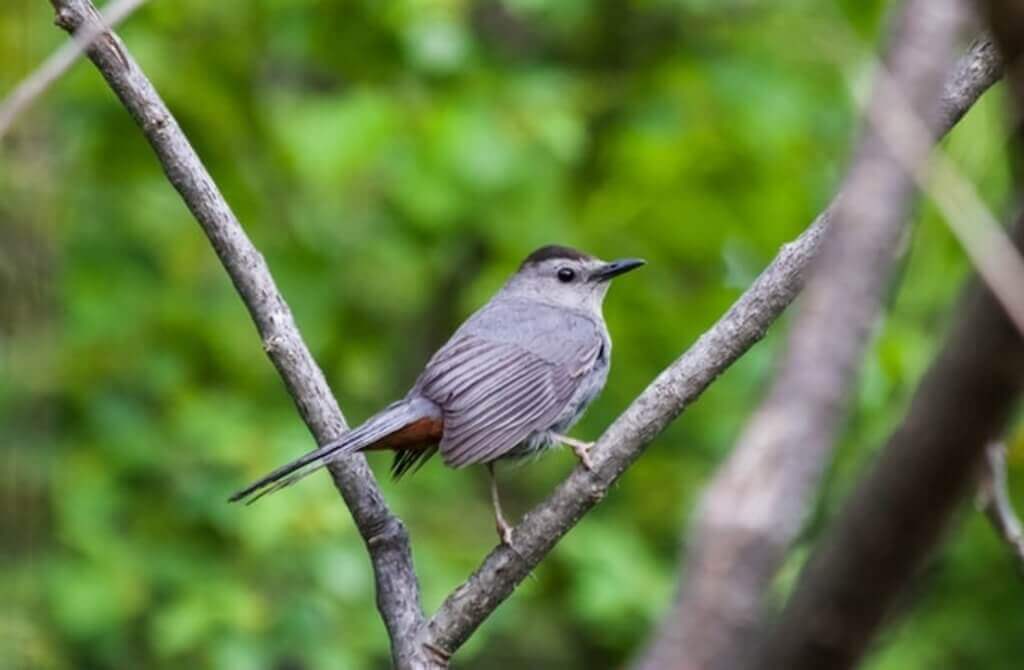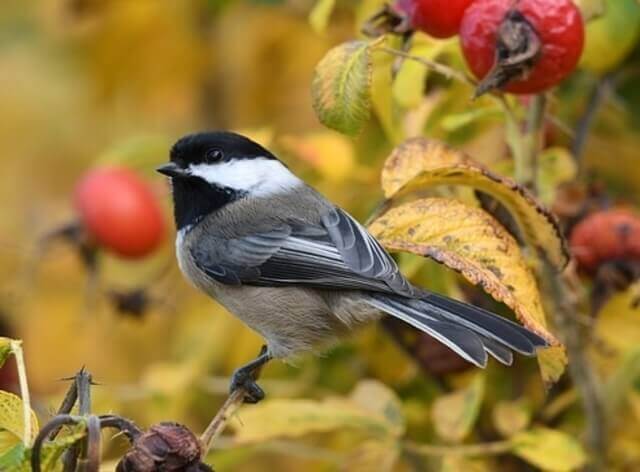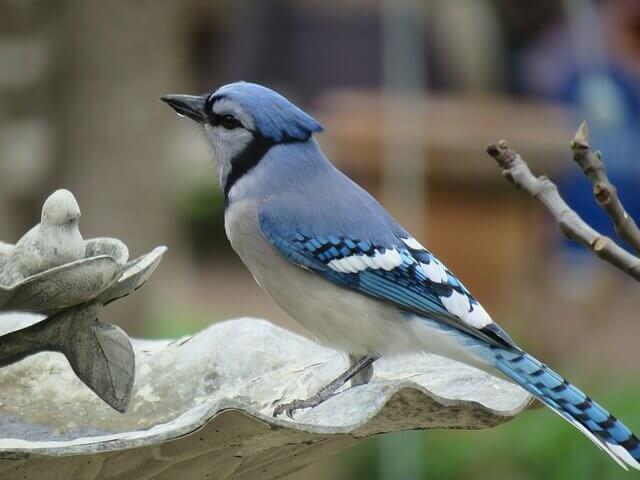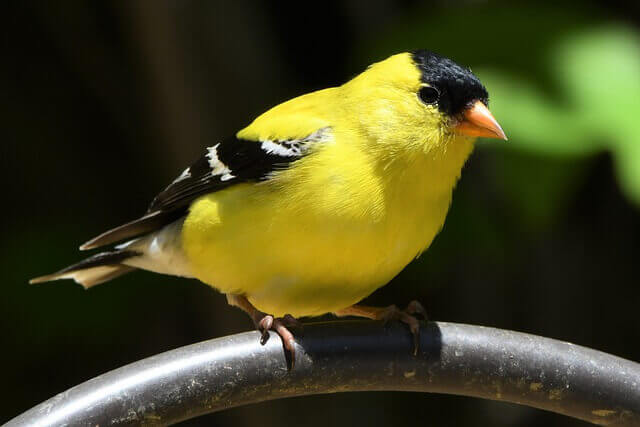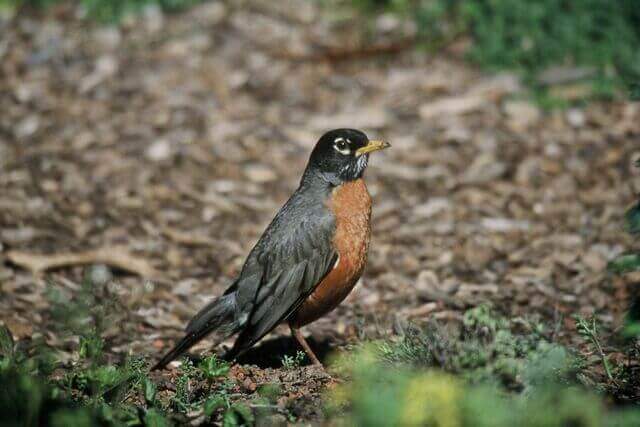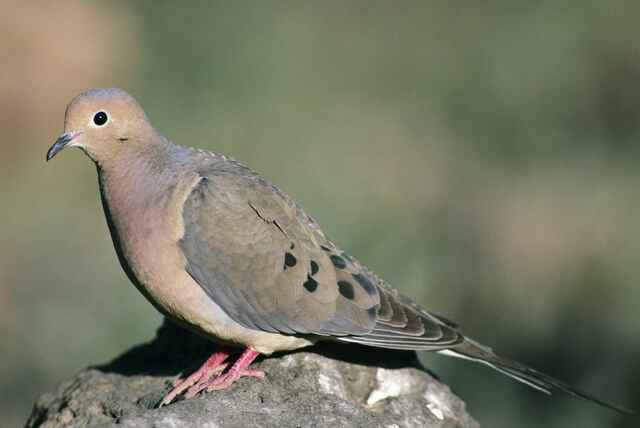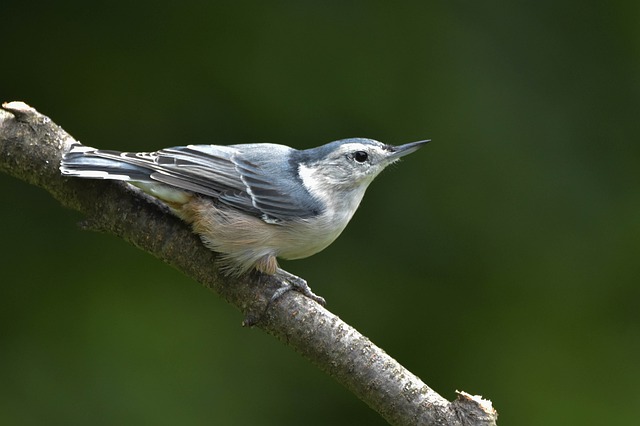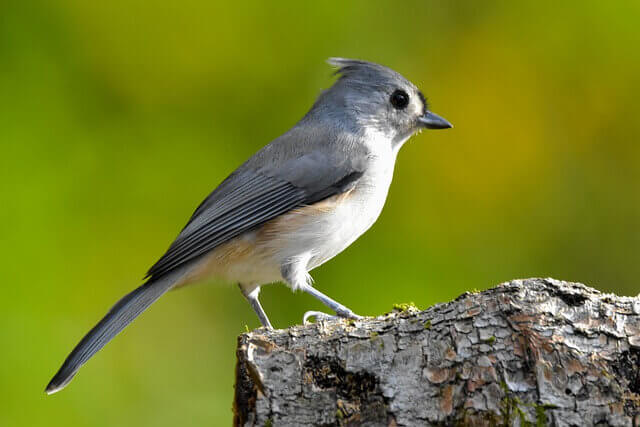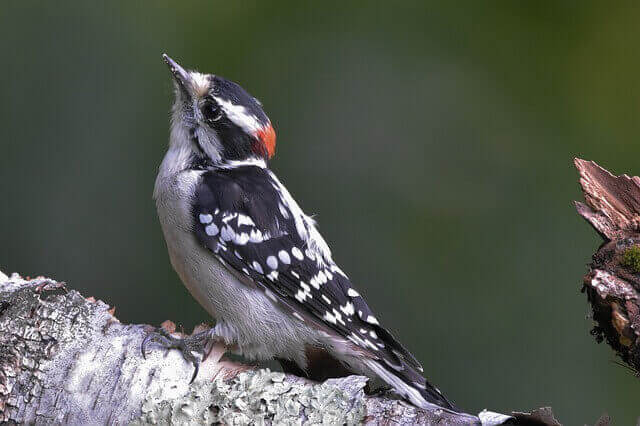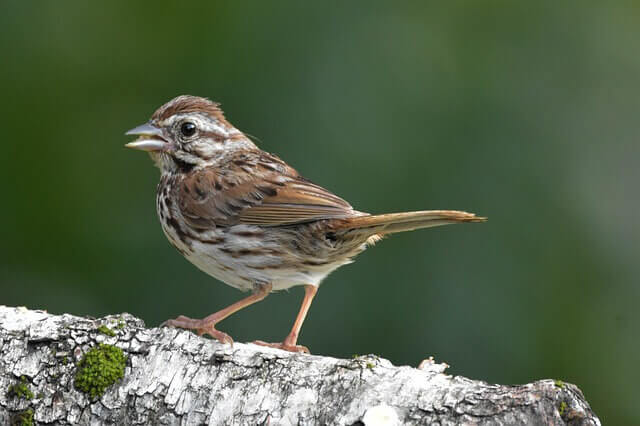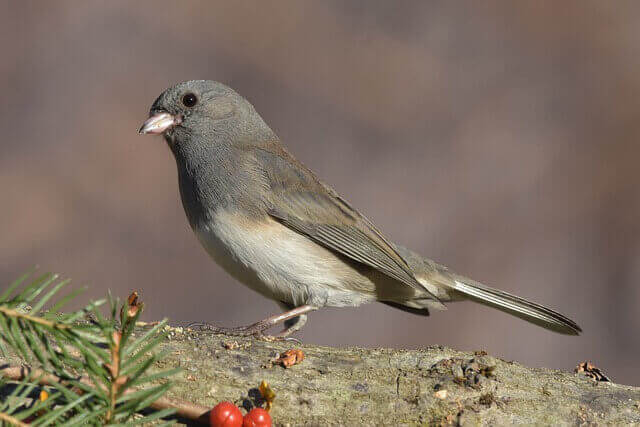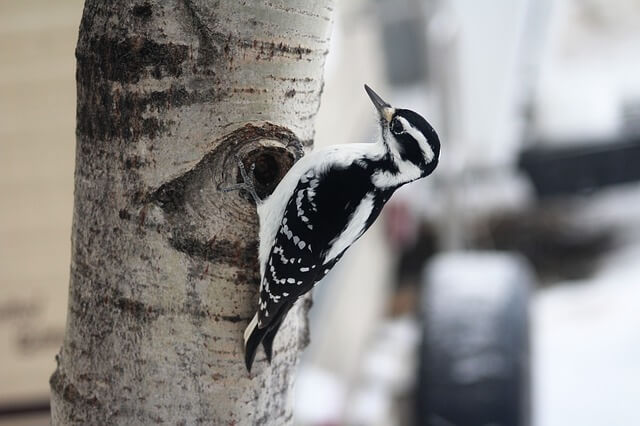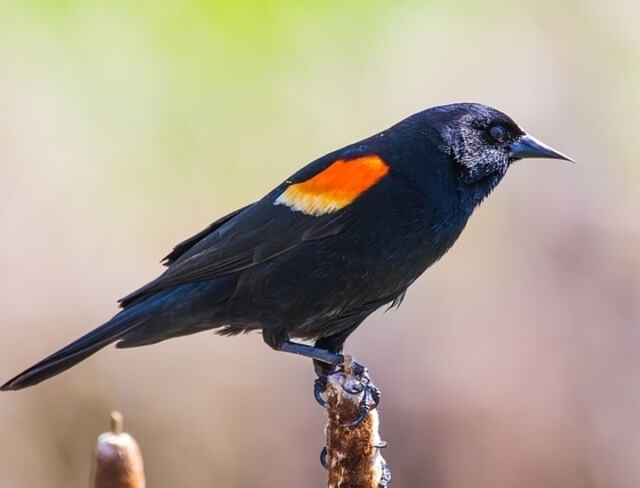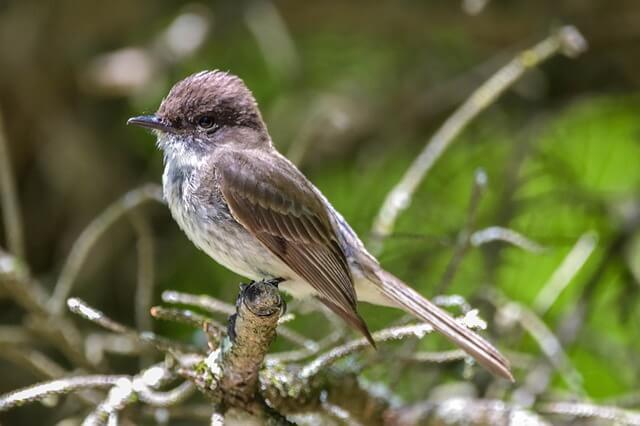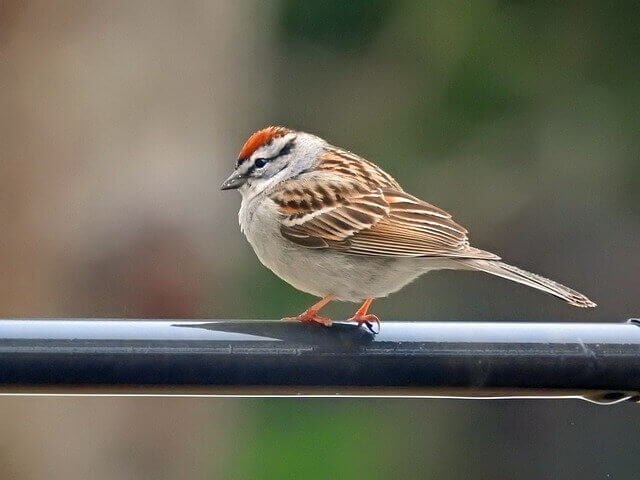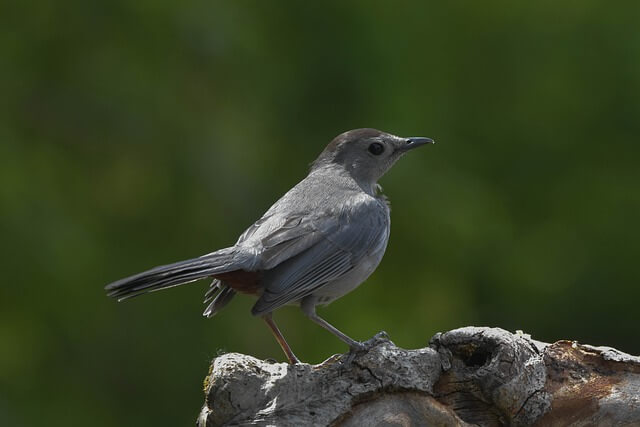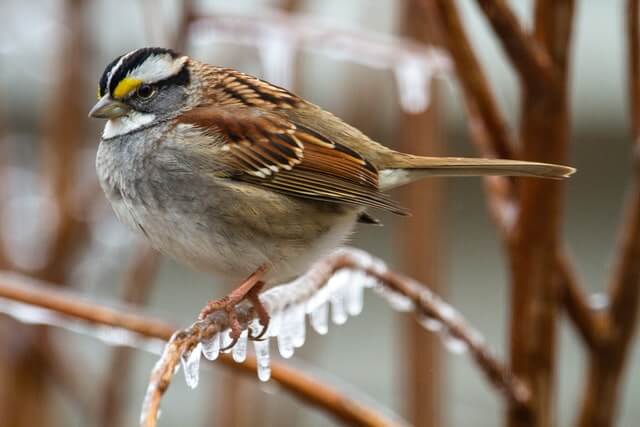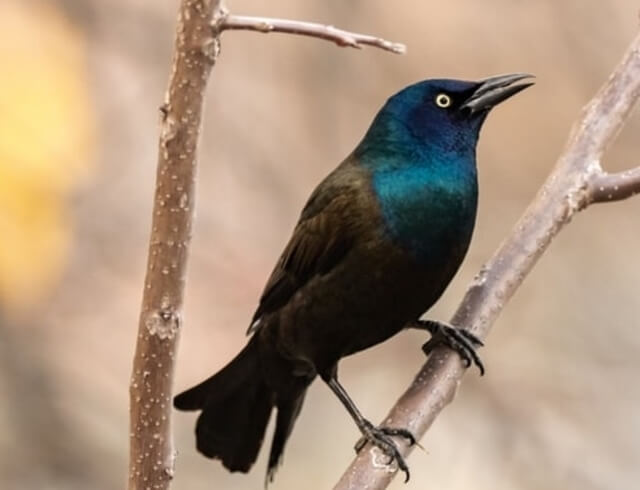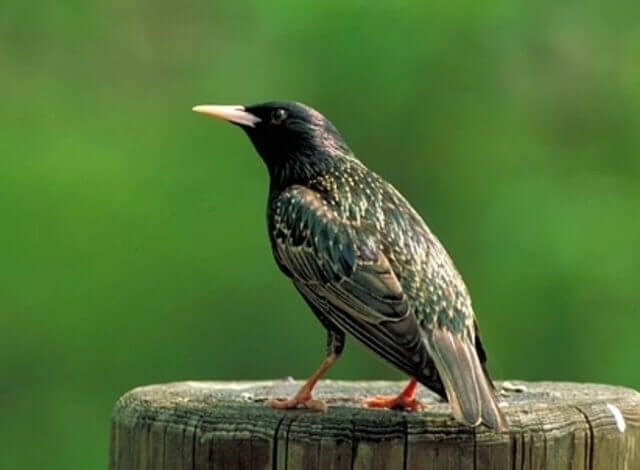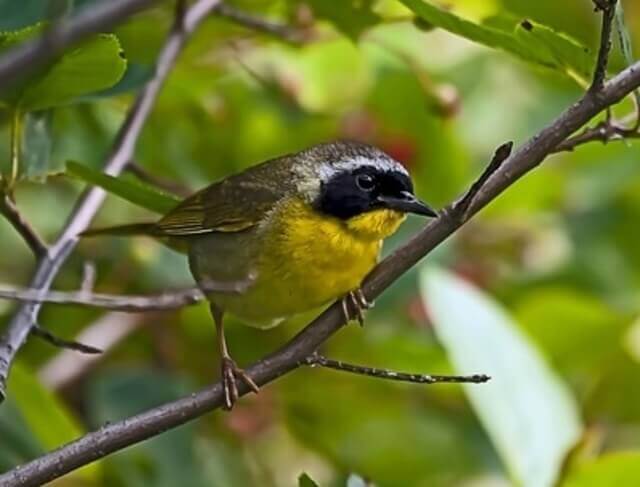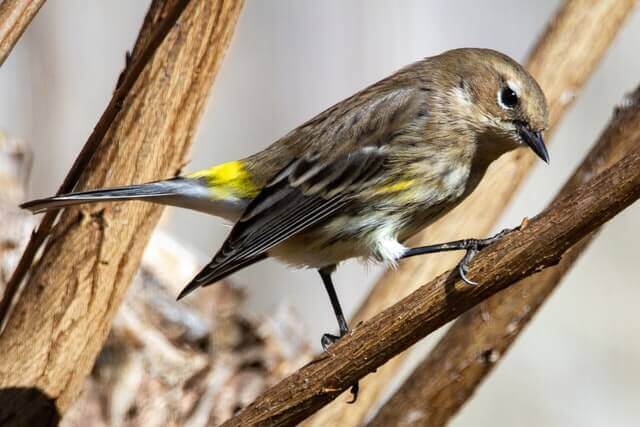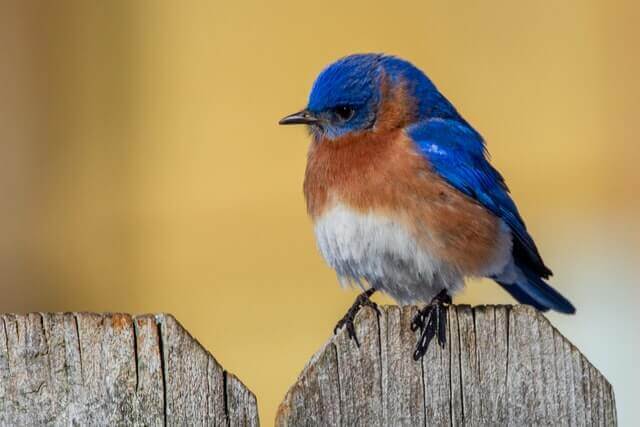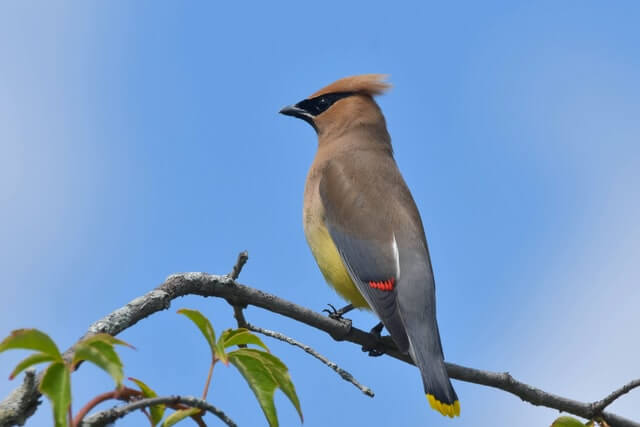Step into the fascinating world of New Hampshire’s diverse bird population with our comprehensive guide. This Ultimate Guide showcases the 50 most common birds found throughout the Granite State, offering insights into their habitats, behaviors, and unique characteristics.
Whether you’re a nature lover, an outdoor enthusiast, or simply curious about the wildlife that surrounds you, this guide provides a captivating glimpse into the avian wonders of New Hampshire. Join us on this exploration and discover the beauty and diversity of the birds that inhabit this scenic state.
Table of Contents
- 1 Most Common Birds in New Hampshire
- 1.1 Black-capped Chickadee
- 1.2 Blue Jay
- 1.3 American Crow
- 1.4 American Goldfinch
- 1.5 American Robin
- 1.6 Mourning Dove
- 1.7 White-breasted Nuthatch
- 1.8 Tufted Titmouse
- 1.9 Downy Woodpecker
- 1.10 Northern Cardinal
- 1.11 Song Sparrow
- 1.12 Dark-eyed Junco
- 1.13 Hairy Woodpecker
- 1.14 Red-winged Blackbird
- 1.15 Eastern Phoebe
- 1.16 Red-breasted Nuthatch
- 1.17 Chipping Sparrow
- 1.18 Gray Catbird
- 1.19 White-throated Sparrow
- 1.20 Common Grackle
- 1.21 European Starling
- 1.22 House Finch
- 1.23 Red-eyed Vireo
- 1.24 Common Yellowthroat
- 1.25 Red-bellied Woodpecker
- 1.26 House Sparrow
- 1.27 Yellow-rumped Warbler
- 1.28 Eastern Bluebird
- 1.29 Cedar Waxwing
- 2 Attracting and Feeding Birds in New Hampshire
- 3 Local Hotspots for Birdwatching in New Hampshire
- 4 Author
Most Common Birds in New Hampshire
Black-capped Chickadee
The Black-capped Chickadee is a small, non-migratory songbird that inhabits the Northern Hemisphere. The black capped chickadee can be found in North America, Europe and Asia. This bird feeds primarily on insects and seeds, but will also eat nuts, berries and tree sap.
In winter, they feed on buds of trees or shrubs that are covered with snow. The range of this species stretches from Alaska to Newfoundland in Canada to southern California in the United States, and southward into Mexico and Central America.
- Frequency: 55.02%
- Color: Black cap, white on face, white/reddish-brown flanks
- Habitat: Deciduous and mixed forests, backyards, parks
- Range: USA and Canada
- Size: 11.5 -16 cm length
- Weight: 8 – 15 grams
- Diet: Insects, seeds, berries
- Family: Paridae
- Genus: Poecile
- Range Map: (See range map)
- Song and Calls: (Listen to sounds)
Blue Jay
Blue Jays are an interesting species of bird. They have a range that stretches from the eastern coast of Canada to Texas and as far south as Panama. These birds live in deciduous forests, mixed forests, coniferous forests, shrub lands and mountainous regions. Blue Jays eat mainly nuts and seeds, but also insects (including grasshoppers), berries, eggs, nestlings and carrion.
Migration patterns for blue jays vary depending on the season. In the winter months, when there is little food available due to leafless trees, they will migrate south as far as South Carolina or Georgia in the United States.
- Frequency: 44.55%
- Color: Blue crest on the head, wings, back, and tail, and has a white face and belly
- Habitat: Deciduous and mixed forests, mixed woodlands, backyards, parks
- Range: Southern Canada, Eastern and Central United States, Florida and Texas
- Size: 8 – 12″ inches
- Weight: 70 – 100 grams
- Diet: Nuts, seeds, caterpillars, grasshoppers, and beetles
- Family: Corvidae
- Genus: Cyanocitta
- Range Map: (See range map)
- Song and Calls: (Listen to sounds)
American Crow
The American Crow is a common and abundant bird in North America. It is found across the United States, Canada, Mexico and some parts of Central America. This bird feeds on both animals and plants as it scavenges for food on the ground or climbs up to eat insects from trees.
It is common throughout North America and inhabits rural areas, suburban neighborhoods, city parks and other places with an abundance of water or food sources. The crow’s diet consists mainly of nuts, seeds, grains and fruits as well as small animals like earthworms and snails.
- Frequency: 37.60%
- Color: Black
- Habitat: Open country, farms, parks, woodlands, towns, cities
- Range: Canada, USA, Mexico
- Size: 16 – 21″ inches
- Weight: 315 -620 grams
- Diet: invertebrates, carrion, seeds, eggs fish, grains, mice, frogs, and other small animals.
- Family: Corvidae
- Genus: Corvis
- Range Map: (See range map)
- Song and Calls: (Listen to sounds)
American Goldfinch
The American Goldfinch is a small bird with a large range. They are native to North America and breed in the northern parts of the continent from Alaska to Newfoundland, as well as in southern Canada from Manitoba to Ontario. Migration patterns for the American Goldfinch are dependent on the location where they live.
Some may migrate to Mexico, Central America, South America and some Caribbean islands. They eat mainly seeds and fruits but also insects such as grasshoppers, crickets, aphids, weevils and beetles when they can find them.
- Frequency: 37.24%
- Color: Face, neck, and underside are yellow, black wings with white bars
- Habitat: Deciduous forests and thickets, roadside, grasslands, backyards, meadows
- Range: Canada, USA and Mexico
- Size: 4.3 – 5.5″ inches length
- Weight: 12 -18 grams
- Diet: Grass, dandelions, chickweed, sunflowers and ragweed, thistle, red alder, birch, spruce seeds
- Family: Carduelinae
- Genus: Spinus
- Range Map: (See range map)
- Song and Calls: (Listen to sounds)
American Robin
The American Robin is a small, but very common bird in North America. These birds live primarily in the eastern half of the United States and Canada during the summer months. The robins migrate to Mexico for winter, where they stay through springtime.
Robins have a wide range of habitats that include fields, pastures, parks and gardens as well as wetland areas near ponds or lakes. Robins eat mainly earthworms, which they find by probing into soft soil with their beaks.
- Frequency: 33.24%
- Color: Mostly brown on the back with an orange-colored breast
- Habitat: Wooded areas, backyards, parks, fields
- Range: USA, Canada, Mexico
- Size: 12 – 16″ inches in length
- Weight: 72 – 95 grams
- Diet: Fruits, berries, and insects (earthworms, beetles, caterpillars)
- Family: Turdidae
- Genus: Turdus
- Range Map: (See range map)
- Song and Calls: (Listen to sounds)
Mourning Dove
The Mourning Doves are a large species of dove that ranges from Southern Canada, the Eastern United States to Northern Mexico. The population in North America is about 350 million. Mourning doves live in habitats with water sources such as rivers, streams or ponds, where they forage for seeds on their ground-level diet.
They can also be found living in agricultural areas and suburban neighborhoods where food is abundant but more scattered about the landscape than in natural settings.
- Frequency: 32.14%
- Color: Light gray-brown and lighter and pinkish below. The wings have black spots.
- Habitat: Open habitats, urban areas, farms, prairie, grassland, wooded area
- Range: USA, Canada, Mexico, Central America, Greater Antilles
- Size: 12″ inches length
- Weight: 112 – 170 grams
- Diet: Rapeseed, corn, millet, safflower, sunflower seeds, pokeberry, sesame, and wheat.
- Family: Columbidae
- Genus: Zenaida
- Range Map: (See range map)
- Song and Calls: (Listen to sounds)
White-breasted Nuthatch
The White-breasted Nuthatch is a small bird in the Sittidae family. They are commonly found across Eastern North America, ranging from Canada to Florida and into Mexico. They have been seen at least as far north as Alaska and Greenland, but not any farther west than the Great Plains of central United States.
The White-breasted Nuthatch prefers habitats with pine trees or hardwoods mixed with evergreens, including deciduous forests, woodlands and old growth forest. The nuthatches have a diet of insects, seeds, nuts and berries which they find on trees or from feeders.
- Frequency: 31.90%
- Color: A White face, flanks, and chest. It has a black cap on its head a bluish-gray upper and a brown belly
- Habitat: Deciduous forests, conifers, roadside, rivers, backyards, parks
- Range: Southern Canada, USA
- Size: 5.9″ inches
- Weight: 20 grams
- Diet: Acorn nuts, hickory nuts, ants, caterpillars, scale insects, pine weevils
- Family: Sittidae
- Genus: Sitta
- Range Map: (See range map)
- Song and Calls: (Listen to sounds)
Tufted Titmouse
The Tufted Titmouse is a small, stocky songbird that weighs an average of 8.6 grams and has a short tail. Their habitat ranges from southern Canada to the eastern United States, with concentrations in the Northeast and Midwest regions of the country. They can be found as far south as Florida, but do not live in California or Texas.
The titmice prefer habitats that are near water or forest with an open understory such as parks, yards, woodlands, fields, brushy areas, and suburbs. In the summer months it eats primarily caterpillars, ants, beetles and spiders. When winter comes around, the diet shifts to include more berries and nuts from trees such as oak or hickory.
- Frequency: 30.77%
- Color: Gray upper, white front, a tufted gray crest on the head
- Habitat: Deciduous forests, river basin, backyards, swamps
- Range: Canada, USA, and Mexico
- Size: 5.5 – 6.4″ inches
- Weight: 18 – 26 grams
- Diet: Nuts, insects, berries, seeds small fruit, and snails
- Family: Paridae
- Genus: Baeolophus
- Range Map: (See range map)
- Song and Calls: (Listen to sounds)
Downy Woodpecker
Downy Woodpeckers are small birds, which are common in North America. They live throughout the Eastern United States and Canada. Downy Woodpeckers have been found in all 50 states except for Alaska and Hawaii. They live in many habitats, such as deserts, prairies, mountains, forests and swamps.
Downy Woodpeckers feed on insects like ants, termites, larvae, earthworms, invertebrates or caterpillars that hide under bark or logs, and nuts, berries, fruits, acorns and seeds from trees such as maple or oak trees. They have the ability to store seeds for winter by putting them into holes in trees or on top of fences posts.
- Frequency: 30.64%
- Color: Black with a white throat, belly, and back. White spots on wings
- Habitat: Deciduous forests and thickets, roadside, grasslands, backyards, parks
- Range: Canada, USA, and Mexico
- Size: 5.5 – 7.1″ inches in length
- Weight: 20 – 33 grams
- Diet: Mostly insects and beetles and ants, also gall wasps, caterpillars
- Family: Picadae
- Genus: Dryobates
- Range Map: (See range map)
- Song and Calls: (Listen to sounds)
Northern Cardinal
Northern Cardinals are one of the most common birds in North America. They are found from southern Canada to northern Mexico and from California to Maine. There is a strong population east of the Rocky Mountains, but there are very few west of the Rockies. The Northern Cardinal prefers mixed forests with an open understory for feeding and dense cover for nesting.
In these areas they can find both fruit-bearing trees like oaks and cherries as well as insect-rich vegetation on which they feed. Cardinals also eat a variety of food items including seeds, fruits, worms, spiders, insects, small lizards, eggs from other birds and frogs.
- Frequency: 28.97%
- Color: Mostly red with a black mask on the face
- Habitat: woodlands, gardens, parks, backyards, and wetlands
- Range: USA, Canada, Mexico
- Size: 8.2 – 9.3″ inches
- Weight: 33 – 65 grams
- Diet: Fruits, berries, and insects (grasshoppers, beetles, snails, cicadas)
- Family: Cardinalidae
- Genus: Cardinalis
- Range Map: (See range map)
- Song and Calls: (Listen to sounds)
Song Sparrow
Song Sparrows are a type of bird that live in North America. These birds have a range that spans from Canada to Mexico, and the United States. They live in many habitats, but typically prefer areas with thick shrubs and dense vegetation. They eat mostly small insects and invertebrates such as spiders, beetles, ants, flies, crickets, grasshoppers, worms and slugs.
Song Sparrows have a song that is often heard near the water or around farmlands when looking for food or nesting sites. The best time to hear their song is during the springtime.
- Frequency: 28.64%
- Color: Gray head, white cheek, a black bib, rufous neck
- Habitat: Urban centers, farms, backyards, edges, yards, and parks
- Range: Europe, Mediterranean, Asia, Australasia, Africa, and the Americas
- Size: 5.5 – 7.0″ inches
- Weight: 25 – 40 grams
- Diet: Grains, seeds, and insects
- Family: Passeridea
- Genus: Passer
- Range Map: (See range map)
- Song and Calls: (Listen to sounds)
Dark-eyed Junco
The Dark-Eyed Junco is a small gray bird that belongs to the sparrow family. The junco lives in the Northern Hemisphere and has a range that includes North America, Europe, Asia, and Greenland. Juncos are found in most types of habitats including forests, deserts, marshes and farmlands.
They will frequently inhabit human structures such as barns or other outbuildings because they like to live near humans for safety reasons. Their diet consists of invertebrates such as beetles, crickets, grasshoppers, caterpillars, spiders; fruit from shrubs and trees. They are migratory birds, meaning they fly south in the winter.
- Frequency: 22.90%
- Color: Gray head, neck, breast, gray/brown backs and wings, white underside
- Habitat: Wooded areas, forest edges, roadsides, gardens, parks.
- Range: USA and Canada
- Size: 5.1 – 6.9″ inches
- Weight: 18 – 30 grams
- Diet: Seeds, insects, and arthropods
- Family: Passeriformes
- Genus: Junco
- Range Map: (See range map)
- Song and Calls: (Listen to sounds)
Hairy Woodpecker
The Hairy Woodpecker is a common North American bird with a large distribution range. They can be found in Canada, the United States, and Mexico. They have a variety of habitats where they live, but most commonly the woodlands, forests, and suburban areas around houses.
Their diet consists mostly of ants and other insects that they find on the ground or get by pecking at tree bark. They will also eat berries, eggs, nuts, spiders, snails, small reptiles such as lizards and snakes, larvae found under logs or rocks.
- Frequency: 20.62%
- Length: 6.7-10.6 in (17-27 cm)
- Weight: 1.4-3.4 oz (40-96 g)
- Wingspan: 12.6-16.5 in (32-42 cm)
- Range: Southeastern United States up into Canada
- Habitat: Forested areas, near rivers and streams, and around farmlands.
- Diet: Insects, nuts, berries and seeds.
- Range Map: (See range map)
- Song and Calls: (Listen to sounds)
Red-winged Blackbird
The Red-winged blackbird is a bird that can be found in North America throughout much of Canada and the United States, excluding Alaska and parts of Northern Canada, although it is more common in warmer climates than colder ones.
The Red-winged blackbird’s habitat includes marshes, open water, wetlands, fields with short grasses or other vegetation for nesting sites and thickets. Their diet consists mainly of insects and small invertebrates they find on land, such as earthworms, beetles and larvae.
- Frequency: 19.40%
- Color: All black with red patches on shoulder and a yellow wing bar
- Habitat: Deciduous forests, conifers, roadside, rivers, backyards, parks
- Range: North America, Central America
- Size: 6.7 – 7.1″ inches length
- Weight: 41.5 – 65 grams
- Diet: Seeds and insects (butterflies, dragonflies, moths, frogs, worms, spider, snails, carrion, flies.)
- Family: Icteridae
- Genus: Agelaius
- Range Map: (See range map)
- Song and Calls: (Listen to sounds)
Eastern Phoebe
The Eastern Phoebe is a small, slender bird that lives in the eastern half of North America. This species breeds primarily near wetlands, rivers, and lakes in open habitats with trees or shrubs for nesting. They also can be found around buildings or on power lines.
Eastern Phoebes eat mostly insects and spiders which they catch by flycatching from perches on high branches or poles. They sometimes follow farmers as they work to catch flies off of livestock or crops too.
- Frequency: 16.26%
- Habitat: Farmland, savanna, and open woodlands, close to the water
- Range: Arizona, Colorado, California, Texas, North Dakota, Massachusetts, Alaska, Canada, Mexico
- Size: 5,5-6.5″ inches
- Weight: 0.6-0.7 oz (16-21 g)
- Wingspan: 10.0-11.0″ in (25-28 cm)
- Diet: Insects, seeds, nectar, and berries
- Family: Tyrannidae
- Genus: Sayornis
- Range Map: (See range map)
- Song and Calls: (Listen to sounds)
Red-breasted Nuthatch
The Red-breasted Nuthatch is a small bird that inhabits the forests of North America. They have an extremely large range, but are primarily found in the northern and eastern regions of Canada. The Red-breasted Nuthatches are part of the Paridae family and are small birds that eat insects, seeds, and berries. They have been observed eating tree sap in a cavity, as well as digging up worms from under leaf litter.
These birds prefer to live in coniferous forests but can also be found living in deciduous forests, parks, backyards with mature trees and shrubs or even urban areas where they can find food sources such as bird feeders.
- Frequency: 16.24%
- Color: It has bluish-gray upperbody and cinnamon underneath, a white throat with a black stripe through the eyes, a gray bill and a black crown.
- Habitat: Deciduous forests, parks, backyards with mature trees and shrubs or even urban areas.
- Range: North America
- Size: 4.5-5.0″ in. – 11.0 cm
- Weight: 10.0 g (0.36 oz)
- Diet: Insects, seeds, and berries.
- Family: Sittidae
- Genus: Sitta
- Range Map: (See range map)
- Song and Calls: (Listen to sounds)
Chipping Sparrow
Chipping Sparrows are small, brown birds that live in a variety of habitats. The chipping sparrows distrubution ranges from southern Canada to Central America and throughout most of the United States excluding Hawaii, Alaska, and northern New England.
Chipping Sparrows typically inhabit grasslands, agricultural fields, shrubby thickets, open woodlands and wet meadows. The diet of these sparrows consists mainly of insects such as caterpillars and spiders. However they also eat seeds from weed plants like milkweed and thistle plants.
- Frequency: 15.45%
- Color: Rust-colored upperparts, gray head, and underparts with a reddish cap on the head
- Habitat: Coniferous forests, woodland, farmland, parks, and gardens
- Range: Southern USA and Mexico
- Size: 4.7 – 5.9″ inches
- Weight: 11 – 16 grams
- Diet: Mostly seeds, spiders
- Family: Passerellidae
- Genus: Spizella
- Range Map: (See range map)
- Song and Calls: (Listen to sounds)
Gray Catbird
The Gray Catbird is a small songbird with the genus Dumetella and belongs to the family Mimidae. They are a pretty common bird species in North America. The birds range from Southern Canada all the way down to Mexico, so they are not too hard to find in any state across America.
They are mostly found in deciduous forests, though they can also be found near marshes, ponds, and woodlands with shrubs or vines for nesting. They feed on insects, seeds, fruits and berries as well as some invertebrates such as snails or slugs that have fallen on the ground.
- Frequency: 15.12%
- Color: Mainly Gray with black on tail and head, white accents on the body
- Habitat: Woodlands, marshes, meadows
- Range: East of the Canadian Rockies, Canada, USA, Mexico, Central America, and the Caribbean
- Size: 8 – 9.5″ inches
- Weight: 23 – 57 grams
- Diet: Fruits, berries, earthworms, beetles, bugs, ants caterpillars, grasshoppers, moths.
- Family: Mimidae
- Genus: Dumatella
- Range Map: (See range map)
- Song and Calls: (Listen to sounds)
White-throated Sparrow
The White-throated Sparrow is a small songbird measuring in at about 6 inches long found in the North America. The song of the male can be heard for miles and will make you think that there are many birds singing. The bird’s range stretches from Eastern Canada to Mexico and Central America, excluding Florida.
The White-throated sparrow can be found in habitats such as dense deciduous or mixed forests, scrubby thickets and woodland edges. These birds feed on seeds and insects which they find on the ground or in vegetation near their nests.
- Frequency: 14.43%
- Color: Brown and gray head pattern. Black-and-white-striped head, white throat, and yellow near the eye.
- Habitat: Deciduous forests and thickets, roadside, grasslands, backyards
- Range: Eastern North America, Atlantic Canada
- Size: 5.9″ – 7.5″ inches long
- Weight: 22 – 32 grams
- Diet: Seeds, insects, and berries
- Family: Passerellidae
- Genus: Zonotrichia
- Range Map: (See range map)
- Song and Calls: (Listen to sounds)
Common Grackle
The Common Grackle is a large blackbird native to North America. It has an extensive range from the southernmost regions of Alaska and Canada down through Mexico and as far south as Argentina. They are often found in small groups, but can also be seen living alone or in pairs.
Common Grackles prefer to live near bodies of water such as lakes, ponds, rivers and marshes. The common grackle feeds primarily on insects such as ants, beetles, caterpillars and grasshoppers but will also eat fruits like apples or berries in late summer.
- Frequency: 14.25%
- Color: Black overall with a blue, and purple iridescence. Its body plumage is a shimmering copper color.
- Habitat: Woodlands, marshes, meadows, parks, backyards and fields
- Range: East of the Canadian Rockies,Canada and the United States
- Size: 11 – 13″ inches length
- Weight: 75 – 143 grams
- Diet: Minnows, eggs, berries, seeds, grain, insects, frogs, mice.
- Family: Icteridae
- Genus: Quiscalus
- Range Map: (See range map)
- Song and Calls: (Listen to sounds)
European Starling
European Starlings are common birds throughout North America, Europe and Asia. Their range covers all but three states, and they can be found throughout the continental United States except for some parts of Alaska. They are also quite diverse in their habitat, living on a variety of different terrain types from urban centers to agricultural fields to wetlands and forests.
European Starlings have a varied diet as well, eating both insects and plants along with small animals such as mice or frogs that live near water sources.
- Frequency: 14.09%
- Color: Black with glossy iridescence plumage
- Habitat: Forests, woodlands, backyards, edges, yards, and parks
- Range: North America, Europe, Africa, India, Middle East, China
- Size: 7 – 9″ inches long
- Weight: 60 – 100 grams
- Diet: Insects (ants, beetles, invertebrates), fruits, seeds, berries
- Family: Picadae
- Genus: Colaptes
- Range Map: (See range map)
- Song and Calls: (Listen to sounds)
House Finch
House finches are an invasive species in North America. They are found all over the continent, but they prefer warmer climates and therefore have a higher population density in the southern United States.They live in open woodlands, scrubby fields, farmlands, suburban areas and parks across their range which includes most of North America east of the Rocky Mountains.
The House Finch’s diet consists of mainly seeds and insects, with some fruits and other vegetation as well. The male house finches have a red breast and head while females have grayish brown plumage on their breasts and head.
- Frequency: 12.90%
- Color: Reddish face and upper breast, brown streaks on back, belly, and tail.
- Habitat: urban and suburban areas, backyards, edges, yards, and parks
- Range: Canada, USA, Mexico
- Size: 5 – 6″ inches
- Weight: 16 – 27 grams
- Diet: Aphids, grains, seeds, berries, nettle, dandelion, sunflower
- Family: Fringillidae
- Genus: Haemorhous
- Range Map: (See range map)
- Song and Calls: (Listen to sounds)
Red-eyed Vireo
The Red-eyed Vireo is a bird found in North America. It ranges from the Eastern Seaboard to as far west as Texas and Arizona, with sightings all throughout Mexico. The birds live in habitats such as deciduous forests, mixed woods and swamps with dense thickets of shrubs or vines.
The males will often sing from exposed perches high up in trees to attract females.The diet of this bird consists mainly of insects, which they can find in dense foliage and trees, as well as on the ground. They also feed on fruits and berries when available.
- Frequency: 12.35%
- Habitat: Deciduous forests, mixed woods and swamps with dense thickets of shrubs or vines.
- Range: Eastern Seaboard to as far west as Texas and Arizona, with sightings all throughout Mexico.
- Size: 4.7-5.0 in (12–13 cm)
- Weight: 0.5-1.0 oz (12-25 g)
- Diet: Insects, fruits and berries
- Family: Vireonidae
- Genus: Vireo
- Range Map: (See range map)
- Song and Calls: (Listen to sounds)
Common Yellowthroat
The Common Yellowthroat is a small, medium-sized warbler. They are a common bird of the eastern United States and Canada. Their range extends from southern New England west to the eastern Great Lakes region and south through the Mississippi Valley to Mexico’s Gulf Coast.
These birds live in open areas with wet or moist ground and tall grasses, often near water sources such as ponds, marshes, streams and creeks. Common Yellowthroats typically eat small animals, insects in fields or gardens but will also take other foods like berries or seeds if they’re available.
- Frequency: 12.25%
- Habitat: Open areas near water sources such as ponds, marshes, streams and creeks.
- Range: Eastern United States and Canada.
- Size: 4.0–5.0 in (10–13 cm)
- Weight: 0.4 oz (8.5 g)
- Diet: Insects, worms, seeds and berries.
- Family: Parulidae
- Genus: Geothlypis
- Range Map: (See range map)
- Song and Calls: (Listen to sounds)
Red-bellied Woodpecker
The Red-bellied woodpecker is a species of bird in the woodpecker family. Their range spans from Southern Canada to Northern Mexico; as well as Eastern United States west to Nebraska and Oklahoma. They are found in forested areas, preferring those with a mix of both deciduous and coniferous trees.
Red-bellied woodpeckers will also be found in mixed pine/oak forests or mixed spruce/fir forests as well as other habitats that have an abundance of dead wood. They feed on insects, seeds, fruits and nuts that they find while tapping on trees with their beaks.
- Frequency: 12.20%
- Length: 9.1-10.6 in (23-27 cm)
- Weight: 1.9-3.2 oz (55-91 g)
- Wingspan: 12.6-16.5 in (32-42 cm)
- Range: Southern Canada to Florida and as far west as Texas.
- Habitat: Deciduous forests as well as mixed forests with both hardwoods and conifers.
- Diet: Seeds, insects, spiders, fruits, berries and nectar.
- Range Map: (See range map)
- Song and Calls: (Listen to sounds)
House Sparrow
House sparrows are one of the most common bird species in North America. They can be found throughout the continent, except for some sparsely populated areas and a few coastal regions. These birds primarily inhabit human-made structures, including cities, suburbs and rural towns.
House sparrows live in densely populated colonies consisting of thousands of nests close together on ledges or rooftops. They eat grains, seeds, insects and other invertebrates found on the ground or vegetation.
- Frequency: 12.14%
- Color: Gray head marking, a reddish-brown back, and gray underparts
- Habitat: Urban centers, suburban areas, backyards, edges, yards, and parks
- Range: North America, Central America, South America, Africa, Australia, New Zealand
- Size: 5.5 – 7.1″ inches in length
- Weight: 25 – 39 grams
- Diet: Insects, beetles, caterpillars, aphids,, grasshoppers, crustaceans, earthworms, vertebrates
- Family: Passeridea
- Genus: Passer
- Range Map: (See range map)
- Song and Calls: (Listen to sounds)
Yellow-rumped Warbler
The Yellow-rumped Warbler is a species of New World warbler. It is a common bird found in North America, Central America and the Caribbean. The birds prefer dense, moist forests with plenty of undergrowth and dead leaves on the ground.
In addition to feeding on insects, they also feed on berries and other fruit during their winter migration south. Yellow-rumped Warblers are most commonly found east of the Rocky Mountains but can be seen as far west as California’s coast during fall migration.
- Frequency: 11.42%
- Color: Yellow patches on the crown, flanks, rump & blackish-blue streaks on the back, breast, and wings
- Habitat: Deciduous forests and thickets, roadside, grasslands, backyards
- Range: U.SA, Canada, Mexico, Central America, and the Caribbean
- Size: 4.7 – 5.9″ inches
- Weight: 10 – 18 grams
- Diet: wasps, beetles, grasshoppers, gnats, aphids, caterpillars, spiders, berries.
- Family: Parulidae
- Genus: Setophaga
- Range Map: (See range map)
- Song and Calls: (Listen to sounds)
Eastern Bluebird
The Eastern Bluebird is a small, common bird found in eastern North America. It can be found year-round in the United States and Canada, with populations migrating south for the winter. Bluebirds live in deciduous and mixed forests with open spaces near water sources such as rivers or lakes.
They find food by searching leaf litter and branches on the ground. They typically feed on insects like beetles, grasshoppers, flies, caterpillars, ants and crickets as well as spiders and earthworms.
- Frequency: 11.05%
- Color: A Blue head, back, and wings. reddish-brown breast
- Habitat: Open woodlands, farmlands, and orchards.
- Range: Southern Canada to the Gulf states, East of the Rockies and south to Arizona to Nicaragua
- Size: 5.5 – 7.1″ inches in length
- Weight: 20 – 33 grams
- Diet: insects and other invertebrates
- Family: Turdidae
- Genus: Sialia
- Range Map: (See range map)
- Song and Calls: (Listen to sounds)
Cedar Waxwing
The Cedar Waxwing is a small songbird that ranges in size from 5-6 inches long. These birds are usually found in the Americas, primarily on the Eastern side of North America and parts of Central America. They also have been spotted as far north as Canada, down to Mexico and across to Argentina.
They have a wide range of habitats including open woodlands, farmlands, parks and suburban areas where they will nest in any type of tree or bush for protection from predators. These birds eat mainly insects, berries and nectar from flowers; they will occasionally dine on some spiders or fruit like cherries or grapes.
- Frequency: 11.02%
- Length: 5.5-6.7 in (14-17 cm)
- Weight: 1.1 oz (32 g)
- Wingspan: 8.7-11.8 in (22-30 cm)
- Range: Southwestern United States to Canada and south through Mexico.
- Habitat: Woodlands, thickets, and gardens that provide shelter and food sources.
- Range Map: (See range map)
- Song and Calls: (Listen to sounds)
The following birds maintain a year-round occurrence frequency of less than 11%.
- Herring Gull 10.80%
- Northern Flicker 10.56%
- Tree Swallow 10.44%
- Common Raven 9.83%
- Great Blue Heron 9.16%
- Turkey Vulture 8.47%
- Red-tailed Hawk 8.19%
- Pileated Woodpecker 8.13%
- Ovenbird 8.03%
- Pine Warbler 7.81%
- Rock Pigeon 7.71%
- Purple Finch 7.71%
- Ring-billed Gull 7.63%
- Ruby-throated Hummingbird 7.30%
- Wood Duck 7.05%
- Black-and-white Warbler 6.71%
- Common Loon 6.68%
- Belted Kingfisher 6.66%
- Black-throated Green Warbler 6.49%
Attracting and Feeding Birds in New Hampshire
One of the joys of birdwatching is bringing these feathered friends closer to home. By creating a welcoming environment, you can enjoy the presence of common New Hampshire birds in your backyard or local area. Here are some practical tips on attracting and feeding these birds:
1. Bird Feeders: Invest in bird feeders designed for the types of birds you want to attract. Different species have varying feeding preferences, so choose feeders that cater to their needs. For instance, tube feeders are great for smaller birds like finches, while platform feeders may attract larger species.
2. Birdhouses: Providing birdhouses or nest boxes can encourage birds to take up residence in your yard. Make sure the dimensions and specifications of the birdhouses match the requirements of the specific bird species you’re targeting.
3. Seed Selection: Choose the right seeds for your target birds. Common choices include sunflower seeds, millet, and cracked corn. Black oil sunflower seeds are generally popular with many bird species.
4. Fresh Water: A birdbath or a shallow dish of clean, fresh water is essential for both drinking and bathing. Ensure it’s changed regularly to maintain cleanliness.
5. Landscape for Birds: Plant native shrubs, trees, and flowers in your garden to provide natural food sources and shelter for birds. Native plants are often best suited to the local bird species.
6. Keep it Clean: Maintain cleanliness in your feeding areas and birdbaths to prevent the spread of disease. Regularly clean and disinfect feeders and water sources.
7. Suet Feeders: Some birds, like woodpeckers, enjoy suet. Consider using suet feeders and offering suet cakes to attract these species.
8. Be Patient: Attracting birds to your yard can take some time. It may take a while for local birds to discover your offerings, so be patient and consistent with your bird-friendly practices.
9. Identification: To attract specific birds, research their dietary preferences and habits. For example, if you want to attract hummingbirds, plant nectar-producing flowers and use hummingbird feeders.
By providing the right food, shelter, and a clean environment, you can create a haven for common New Hampshire birds right in your own backyard. Remember, the goal is not just to attract birds for your enjoyment but also to provide a safe and nurturing habitat for them.
Local Hotspots for Birdwatching in New Hampshire
While New Hampshire offers numerous opportunities for birdwatching, some locations are particularly renowned for their diverse avian populations. If you’re eager to observe the 50 most common birds in the state, consider visiting these local hotspots:
- Odiorne Point State Park: Located along the seacoast, this park offers a mix of coastal and forest habitats, making it an ideal spot for both migratory and resident birds.
- Pisgah State Park: This extensive wilderness area in southwestern New Hampshire boasts a variety of ecosystems, including wetlands, woodlands, and open fields, making it a birdwatcher’s paradise.
- Lake Massabesic: This lake and its surrounding woodlands are a haven for waterfowl and songbirds. You can explore the extensive network of trails for great birdwatching opportunities.
- White Mountains: The White Mountain region is not just about stunning landscapes; it’s also a habitat for several bird species. Head to popular trails and scenic spots for mountain birdwatching.
- Great Bay National Wildlife Refuge: Situated along the coast, this refuge is home to many species of waterfowl and shorebirds. Bring your binoculars for excellent birdwatching along the estuaries and marshes.
- Squam Lake: The tranquility of Squam Lake, as well as its surrounding woodlands, offers an excellent chance to spot waterfowl, raptors, and various songbirds.
- Mount Monadnock: Hiking up Mount Monadnock can be a rewarding birdwatching experience. The higher elevations provide opportunities to observe unique mountain bird species.
- Moose Bog: This remote location in the North Country is perfect for observing boreal bird species in their natural habitat.
- Harris Center for Conservation Education: Located in Hancock, this center not only provides educational programs but also great birdwatching opportunities with their well-maintained trails.
- New Hampshire Audubon Centers: The Audubon centers throughout the state, including Massabesic Center in Auburn and McLane Center in Concord, offer a wealth of information, organized birdwatching events, and prime birdwatching sites.
These hotspots offer a wide range of environments and bird species. Whether you’re a seasoned birder or just starting your birdwatching journey, these locations in New Hampshire are sure to provide memorable encounters with the state’s diverse avian residents. Don’t forget to bring your binoculars, a field guide, and a sense of wonder as you explore these birdwatching destinations!

